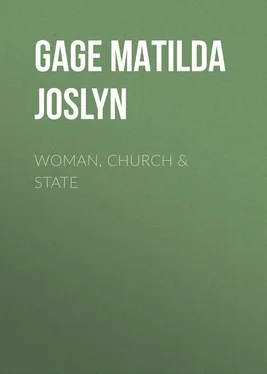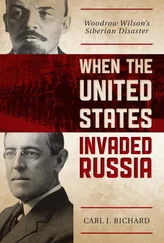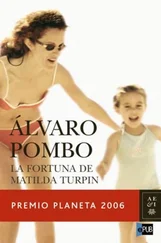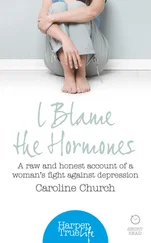Matilda Gage - Woman, Church & State
Здесь есть возможность читать онлайн «Matilda Gage - Woman, Church & State» — ознакомительный отрывок электронной книги совершенно бесплатно, а после прочтения отрывка купить полную версию. В некоторых случаях можно слушать аудио, скачать через торрент в формате fb2 и присутствует краткое содержание. Жанр: foreign_antique, foreign_prose, на английском языке. Описание произведения, (предисловие) а так же отзывы посетителей доступны на портале библиотеки ЛибКат.
- Название:Woman, Church & State
- Автор:
- Жанр:
- Год:неизвестен
- ISBN:нет данных
- Рейтинг книги:3 / 5. Голосов: 1
-
Избранное:Добавить в избранное
- Отзывы:
-
Ваша оценка:
- 60
- 1
- 2
- 3
- 4
- 5
Woman, Church & State: краткое содержание, описание и аннотация
Предлагаем к чтению аннотацию, описание, краткое содержание или предисловие (зависит от того, что написал сам автор книги «Woman, Church & State»). Если вы не нашли необходимую информацию о книге — напишите в комментариях, мы постараемся отыскать её.
Woman, Church & State — читать онлайн ознакомительный отрывок
Ниже представлен текст книги, разбитый по страницам. Система сохранения места последней прочитанной страницы, позволяет с удобством читать онлайн бесплатно книгу «Woman, Church & State», без необходимости каждый раз заново искать на чём Вы остановились. Поставьте закладку, и сможете в любой момент перейти на страницу, на которой закончили чтение.
Интервал:
Закладка:
One of the most brilliant modern examples of the Matriarchate was found in Malabar at the time of its discovery by the Portuguese in the XV century. The Nairs were found to possess a fine civilization, entirely under the control of women, at a period when woman’s position in England and on the Continent of Europe, was that of a household and political slave. Of Malabar it has been said, that when the Portuguese became acquainted with the country and the people, they were not so much surprised by the opulence of their cities, the splendor of all their habits of living, the great perfection of their navy, the high state of the arts, as they were to find all this under the entire control and government of women. The difference in civilization between christian Europe and pagan Malabar at the time of its discovery was indeed great. While Europe with its new art of printing, was struggling against the church for permission to use type, its institutions of learning few, its opportunities for education meagre; its terrible inquisition crushing free thought and sending thousands each year to a most painful death, the uncleanliness of its cities and the country such as to bring frequent visits of the plague; its armies and its navies with but one exception, imperfect; its women forbidden the right of inheritance, religious, political, or household authority; – the feminine principle entirely eliminated from the divinity – a purely masculine God the universal object of worship, all was directly the opposite in Malabar. Cleanliness, peace, the arts, a just form of government, the recognition of the feminine both in humanity and in the divinity were found in Malabar. To the question of a Danish missionary concerning their opinion of a Supreme Being, this beautiful answer was given.
The Supreme Being has a Form and yet has no Form; he can be likened to nothing; we cannot define him and say that he is this or that; he is neither Man or Woman; neither Heaven or Earth, and yet he is all; subject to no corruption, no mortality and with neither sleep nor rest, he is Almighty and Omnipotent without Beginning and without End. 18 18 Account of the Religion, Manners, etc., of the People of Malabar, etc. , translated by Mr. Phillips, 1718.
Under the Missionaries sent by England to introduce her own barbaric ideas of God and man, this beautiful Matriarchal civilization of Malabar soon retrograded and was lost.
The ancient Mound Builders of America, of whom history is silent and science profoundly ignorant, are proven by means of symbolism to have been under Matriarchal rule, and Motherhood religion. Anciently motherhood was represented by a sphere or circle. The circle, like the mundane egg, which is but an elongated circle, contains everything in itself and is the true microcosm. It is eternity, it is feminine, the creative force, representing spirit. Through its union with matter in the form of the nine digits it is likewise capable of representing all natural things. 19 19 Among the illustrative types of interior realities and the elementary geometric forms, point, direct line and deflected line, the last of which is a true arc produces the circle when carried to its ultimate, this circle representing the triune order of movement; the point in the line, the line in the curve, and the curve in the circle — The Path .
The perfect circle of Giotto was an emblem of divine motherhood in its completeness. It is a remarkable fact – its significance not recognized, – that the roughly sketched diameter within the circle, found wherever boys congregate, is an ancient mystic sign 20 20 The phallus and lingum (or lingum and yoni), the point within the circle or diameter within the circle. — Volney’s Ruins .
signifying the male and female, or the double-sexed deity. It is the union of all numbers, the one within the zero mark comprising ten, and as part of the ancient mysteries signifying God, the creative power, and eternal life; it was an emblem of The All.
In many old religions, the generative principle was regarded as the mother of both gods and men. In the Christian religion we find tendency to a similar recognition in Catholic worship of the Virgin Mary. The most ancient Aryans were under the Matriarchate, the feminine recognized as the creative power. The word ma from which all descendants of those peoples derive their names for mother, was synonymous with Creator . Renouf, the great antiquarian authority upon the Aryan’s, 21 21 Chips from a German Work-Shop . – Max Muller.
gives the songs and ceremonies of the wedding. In these, the woman is represented as having descended to man from association with divine beings in whose custody and care she has been, and who give her up with reluctance. In Sanscrit mythology, 22 22 All mythology has pertinently been characterized as ill-remembered history.
the feminine is represented by Swrya, the Sun, the source of life, while the masculine is described as Soma, a body. Soma, a beverage of the gods especially sacred to Indra, was the price paid by him for the assistance of Vayu, the swiftest of the gods, in his battle against the demon Vritra. A curious line of thought is suggested. The marriage of the man to the woman was symbolized as his union with the gods. Soma, a drink devoted to Indra, the highest god, signified his use of a body, or the union of spirit and body. In the same manner, woman representing spirit, by her marriage to man became united with a body. As during the present dark age, the body has been regarded more highly than the spirit, we find a non-recognition of the woman, although the union of spirit and body is symbolized in the Christian church by the sacrament of bread and wine. During the purest period of Aryan history marriage was entirely optional with woman and when entered into, frequently meant no more than spiritual companionship. Woman equally with man was entitled to the Brahminical thread; she also possessed the right to study and preach the Vedas, which was in itself a proof of her high position in this race. The Vedas, believed to be the oldest literature extant, were for many ages taught orally requiring years of close application upon part of both teacher and student.
The word Veda signifies “to-know”; the latter from Vidya meaning “wise.” The English term widow is traceable to both forms of the word, meaning a wise woman – one who knows man. Many ages passed before the Vedas were committed to writing. 23 23 In the Rig-Veda, a work not committed to writing until after that movement of the Aryans, which resulted in the establishment of Persia and India … there is nothing more striking than the status of woman at that early age. Then the departed mothers were served as faithfully by the younger members of the family as departed fathers. The mother quite as often, if not more frequently than the father conducted the services of the dead ancestry, which took place three times a day, often consisting of improvised poetry. — Elizabeth Peabody on the Aryans .
At that early day the ancestral worship of women – departed mothers – was as frequent as that of departed fathers, women conducting such services which took place three times a day. In the old Aryan Scriptures the right of woman to hold property, and to her children, was much more fully recognized than under the Christian codes of today. Many of the olden rights of women are still extant in India. The learned Keshub Chunder Sen vigorously protested against the introduction of English law into India, upon the ground that it would destroy the ancient rights of the women of that country. It was primal Indian law that upon the death of the husband the wife should heir all his property. Marriage was regarded as an eternal union, the two, by this act, having so fully become one, that upon the husband’s death, one half of his body was still living. The property and the children were held as equally belonging to the husband or the wife.
Интервал:
Закладка:
Похожие книги на «Woman, Church & State»
Представляем Вашему вниманию похожие книги на «Woman, Church & State» списком для выбора. Мы отобрали схожую по названию и смыслу литературу в надежде предоставить читателям больше вариантов отыскать новые, интересные, ещё непрочитанные произведения.
Обсуждение, отзывы о книге «Woman, Church & State» и просто собственные мнения читателей. Оставьте ваши комментарии, напишите, что Вы думаете о произведении, его смысле или главных героях. Укажите что конкретно понравилось, а что нет, и почему Вы так считаете.












